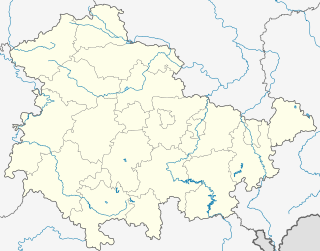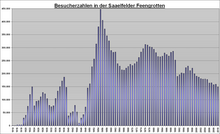Fairy grottoes
| Fairy grottoes
|
||
|---|---|---|
|
"Fairytale Dome" |
||
| Location: | Saalfeld / Saale , Germany | |
|
Geographic location: |
50 ° 38 '6 " N , 11 ° 20' 29" E | |
|
|
||
| Geology: | Alum slate | |
| Type: | Show mine | |
| Discovery: | 1910 | |
| Show cave since: | 1914 | |
| Lighting: | electric | |
| Average annual number of visitors: | 160,000 | |
| Current visitors: | 149,630 (2010) | |
| Website: | www.feengrotten.de | |
The fairy grottoes (mostly: Saalfeld fairy grottoes) are a show mine that emerged from a disused mine in Saalfeld , Thuringia , on the edge of the Thuringian slate mountains . It opened in 1914. The fairy grottoes are especially famous for their colored stalactites .
Show mine
The fairy grottoes are the former alum slate mine "Jeremias Glück" and have been in the Guinness Book of Records as "The most colorful exhibition grottoes in the world" since 1993 . This name goes back to the special geological background of the mine. Due to the iron and mineral-rich environment , many different colors can be found; the well over 100 shades of brown are particularly noteworthy.
The show mine consists of three levels , the designation of the floors in a mine.
- On the first level, information about the origins and interesting facts about the work, the measurements made by the Markscheider using the degree arc and the life of the miners are conveyed. The emanatorium of the fairy grottoes is also located on this floor - opened on September 10, 1937 as one of the first healing galleries in Germany.
- On the second level of the mine you are already 26 meters underground at the deepest point and at the actual place of discovery of the fairy grottoes. Around 1910, scientists were looking for the source of the water emerging from the mountain, which was believed to have beneficial effects. These grottos were called the "source grottoes" after the place where they were found. The medicinal water, which was very rich in minerals, was sold until the mid-1960s. The healing springs have dried up, but the lighter mineralized water “Grail Spring” is still being pumped from a deep well.
- The fairy tale dome on the third level is the oldest and most beautiful cavity in the fairy grottoes. The age of the stalactites is around 250-300 years. A special feature is the Grail Castle in the background, formed from a collection of partly overgrown stalactites. This setting inspired Siegfried Wagner , the son of the composer Richard Wagner , in the 1920s, as part of the Bayreuth Festival, to create a stage design for the opera "Tannhäuser".

In front of the exit you can see a “root stalactite”. It belongs to a more than 200-year-old, double-stemmed oak that has driven its roots 10 meters deep into the mountain. The tree itself can be seen just a few steps away from the fountain temple where the tour ends.
Formation of the stalactites
The growth rate of stalactites in the Fairy Grottoes is probably a thousand times the stalactite growth in Karbonatkarst . The reason for this is the material of the stalactites, the relatively soft substance diadochite or mountain butter, an iron (III) -hydroxy-phosphate-sulfate-hydrate. It was examined and described in detail by August Breithaupt in 1837 . The Saalfeld fairy grottoes are the type locality for them (locus typicus).
The mine is located in Silurian alum and silica schist . The dissolution process is linked to oxidative processes, some of which are induced by micro-bacteria, i.e. the oxidation with oxygen from the groundwater first leads to the formation of water-soluble substances, which are then transported away. Various minerals are precipitated in the pit according to the hydrochemical conditions.
In the meantime, over 45 minerals have been reliably detected in the fairy grottoes. Essentially, there are sulfides , oxides , carbonates , sulfates , phosphates , vanadates , arsenates and silicates . Since these are very different substances with different colors, the stalactites have an unusual color.
History of the mine
Alum slate mine
Active mining began around 1530 in the Arnsgereuther valley above Garnsdorf and thus also in the area of today's fairy grottos. Rather high-quality ore was sought, but only alum shale was found , for which there was no use yet. Scheduled mining began around 1544. By leaching the gray-black rock, alum was obtained for tanning leather, and later green and, to a lesser extent, blue vitriol . In 1599 there is said to have been a first boiling hut for the extraction of alum and vitriol. It was not until 1757 that it was possible to keep a mining operation that had lasted for many decades alive. Until 1760 Johann Ehrenreich Jeremias and Johann Jacob Nolde kept the mining going. The mine, now called "Jeremias Glück", came into the possession of the Leipzig merchant and banker family Frege , who continued to operate the mine, which only made a profit in the first decade, despite the lack of profitability due to the lack of alternatives in alum and vitriol production. In 1764 a vitriolic boiling hut was put into operation, which remained in the same place until the new spring house was built in 1927. The beginning of industrialization and the development of chemical products with significantly higher degrees of purity brought mining to a standstill around 1850. Dr. Waldemar von Frege gave the mine and mining rights to the Bergfrei in 1860.
In 1867, the Saalfeld entrepreneur August Wohlfarth had the pit water dammed up in the long tunnel, the access to the second level at that time, in order to extract the iron ocher deposited in it for the purpose of pigment paint production. The ocher had too little opacity and too many annoying admixtures and was inferior to colors in the chemical industry. In 1909 the ocher extraction was finally stopped.

Show mine and destination
In 1910 the tunnel of the almost forgotten mine was rediscovered. The mineral-rich drip and spring water had created a fascinating stalactite world in less than 300 years. On December 22nd, 1913, the third floor was discovered with the fairytale dome and the famous stalactite inside. This gave the final impetus to open the fairy grottoes as a show mine to the public. The naming Feengrotten , Märchendom , Grail Castle comes from the geologist Hans Hess von Wichdorff , who was known throughout Germany at the time .
The Saalfeld fairy grottoes were opened on May 31, 1914. When it opened, a café was created, the “Grottenschenke”. This was expanded in the 1950s by a lightweight extension and the guest room was closed. In 1998 the building was completely renovated according to historical templates in the style of the 1920s. Since then, the cave tavern has been used as an excursion restaurant and for celebrations.
The spring house was built in 1927 as the seat of the spring research institute founded three years earlier for the purpose of investigating the healing springs of the Saalfeld fairy grottoes. Research laboratories were mainly housed in the rooms of the source house. In the basement there was a bottling plant for the healing and mineral waters obtained from the fairy grottoes. There was also a ballroom that was later converted into today's “Gasthaus Feengrotten”.
Saalfeld fairy grottoes today
Today the administration of the Saalfelder Feengrotten und Tourismus GmbH, three guest rooms and a holiday apartment are located in the Quellenhaus next to the inn. In the course of a redesign, the adventure museum “Grottoneum” was set up in 2011. The inn has been extensively renovated. The motifs of the originally preserved glass mosaic panes in the stairwell of the spring house indicate the importance and healing power of the waters of the fairy grottoes: Recentis vivum aqua - refreshed by living water, Salus et vitalis - well-being and vitality .
The outdoor area includes the fountain hall inaugurated on July 9, 1937, the “fountain temple”, the place where the healing and mineral waters contained in the grottos and directed to the outside for treatment, which was restored in 1998, and a “craftsmen's yard” are located. Furthermore, a play and adventure area "Feenweltchen" has been set up on the site. In addition to the usual tours through the mine, there are daily tours for children. In addition, the fairy caves are used as a healing gallery for speleological or cave therapy as an alternative or supplement to conventional medicine with no side effects for respiratory diseases such as asthma and bronchitis as well as skin diseases and allergies. The Saalfeld fairy grottoes are a member of the German Healing Gallery Association .
Since 1914, over 18 million people (as of 2016) have visited the mine; including well-known personalities. The then Reich President Friedrich Ebert visited the fairy grottoes on August 18, 1919. The Saalfeld fairy grottoes are visited by around 160,000 tourists every year, making them the second most popular German show cave after the Atta cave .
literature
See also
Remarks
- ↑ In the sense of the definition, the fairy grottoes as a cavity created by a mine are not a show cave, but a show mine. The Saalfeld fairy grottoes are a member of the Association of German Cave and Karst Researchers and are listed there as a show cave.
Individual evidence
- ^ History of the Saalfeld fairy grottoes - fairy grottoes. Retrieved July 12, 2020 .








